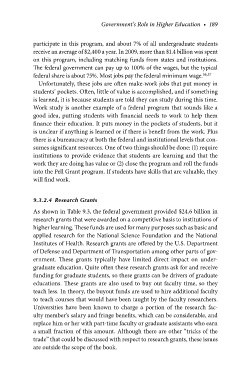Page 218 - Crisis in Higher Education
P. 218
Government’s Role in Higher Education • 189
participate in this program, and about 7% of all undergraduate students
receive an average of $2,400 a year. In 2009, more than $1.4 billion was spent
on this program, including matching funds from states and institutions.
The federal government can pay up to 100% of the wages, but the typical
federal share is about 75%. Most jobs pay the federal minimum wage. 36,37
Unfortunately, these jobs are often make-work jobs that put money in
students’ pockets. Often, little of value is accomplished, and if something
is learned, it is because students are told they can study during this time.
Work study is another example of a federal program that sounds like a
good idea, putting students with financial needs to work to help them
finance their education. It puts money in the pockets of students, but it
is unclear if anything is learned or if there is benefit from the work. Plus
there is a bureaucracy at both the federal and institutional levels that con-
sumes significant resources. One of two things should be done: (1) require
institutions to provide evidence that students are learning and that the
work they are doing has value or (2) close the program and roll the funds
into the Pell Grant program. If students have skills that are valuable, they
will find work.
9.3.2.4 Research Grants
As shown in Table 9.3, the federal government provided $24.6 billion in
research grants that were awarded on a competitive basis to institutions of
higher learning. These funds are used for many purposes such as basic and
applied research for the National Science Foundation and the National
Institutes of Health. Research grants are offered by the U.S. Department
of Defense and Department of Transportation among other parts of gov-
ernment. These grants typically have limited direct impact on under-
graduate education. Quite often these research grants ask for and receive
funding for graduate students, so these grants can be drivers of graduate
educations. These grants are also used to buy out faculty time, so they
teach less. In theory, the buyout funds are used to hire additional faculty
to teach courses that would have been taught by the faculty researchers.
Universities have been known to charge a portion of the research fac-
ulty member’s salary and fringe benefits, which can be considerable, and
replace him or her with part-time faculty or graduate assistants who earn
a small fraction of this amount. Although there are other “tricks of the
trade” that could be discussed with respect to research grants, these issues
are outside the scope of the book.

